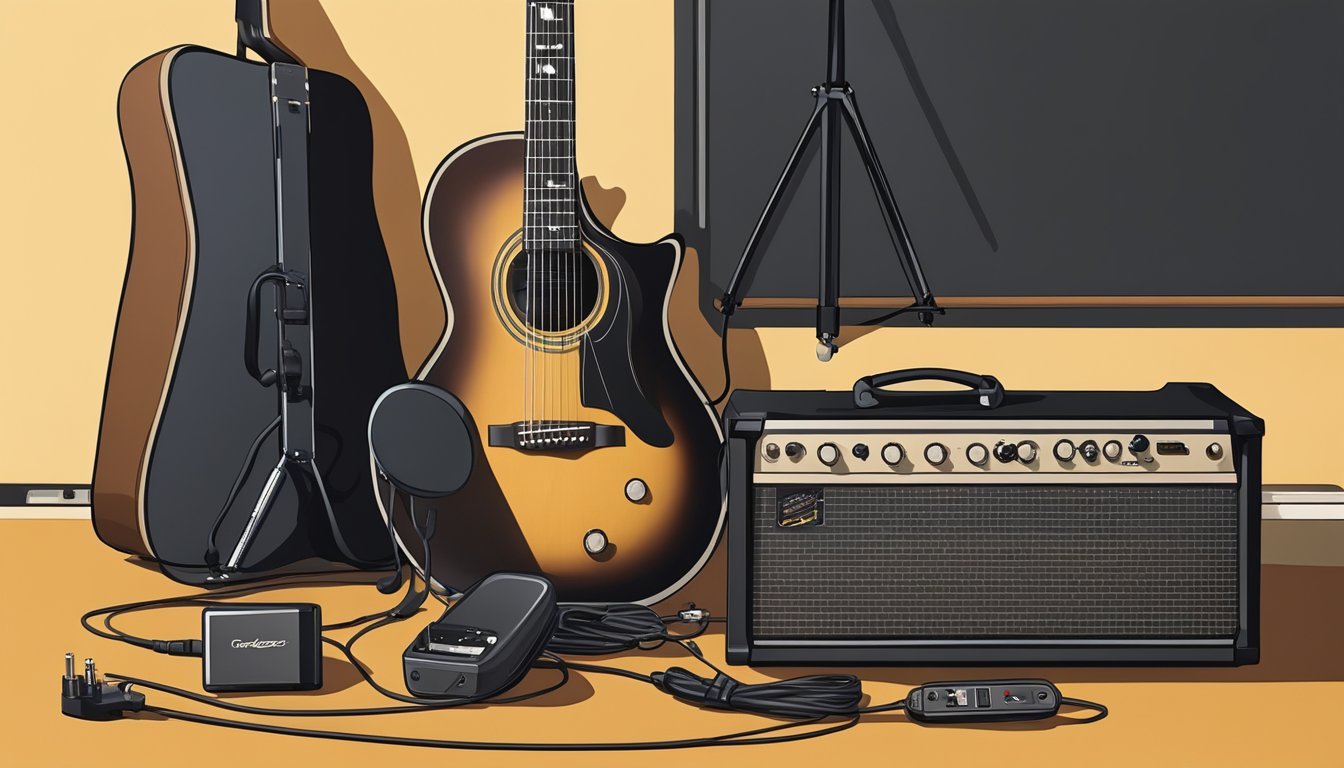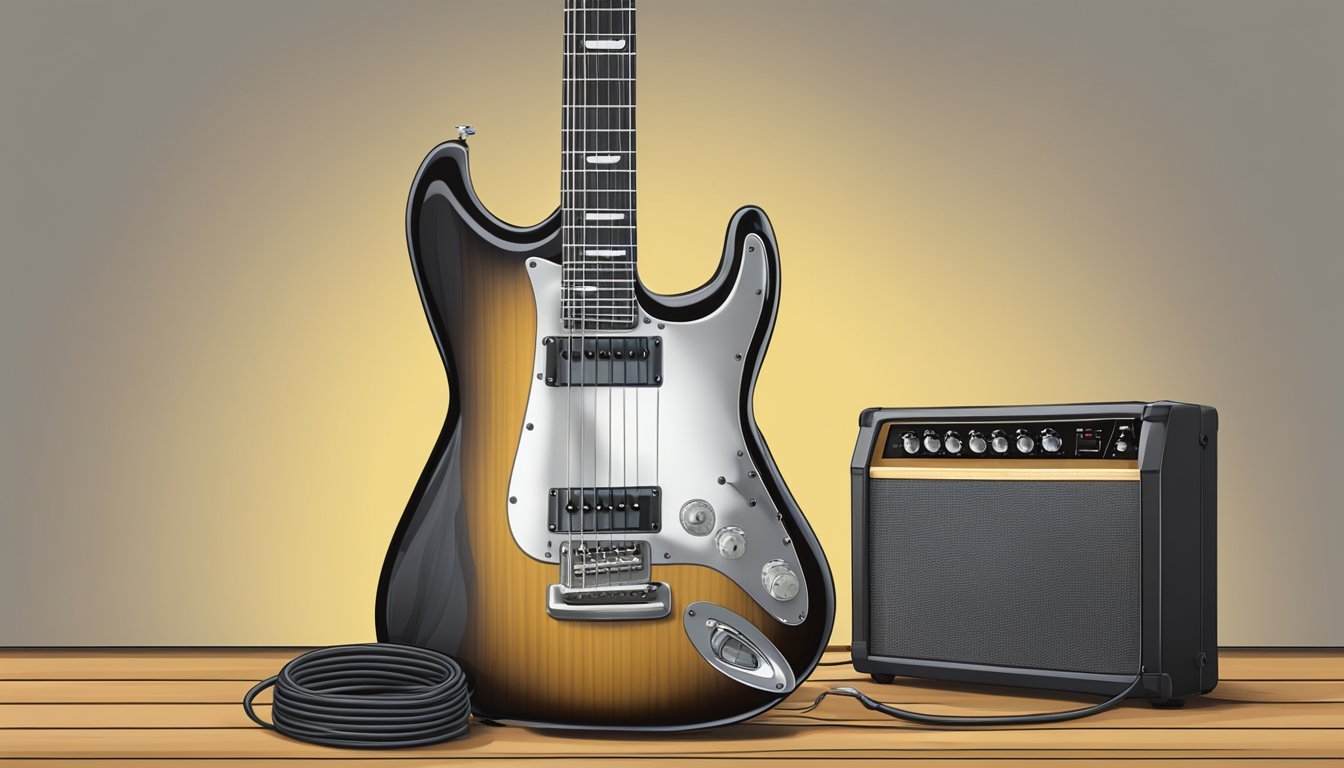An acoustic-electric guitar combines the traditional features of an acoustic guitar with modern technology.
Its built-in electronics allow you to amplify the sound with ease, making it perfect for live performances and jam sessions.
This guitar type offers the warm, natural tones of an acoustic while providing the ability to reach larger audiences without losing sound quality.

An acoustic-electric guitar is perfect for playing in a cozy café or on a grand stage.
It gives you the flexibility to play anywhere without needing separate microphones.
Whether you’re a beginner looking for versatility or a seasoned musician wanting to enhance your sound, this guitar type can fit your needs.
Key Takeaways
- Acoustic-electric guitars combine acoustic sounds with built-in amplification.
- They are versatile for various music styles, making them popular among musicians.
- Proper care and the right gear enhance your playing experience.
Understanding Acoustic Electric Guitars
Acoustic electric guitars blend the classic sound of an acoustic guitar with modern technology.
They allow you to amplify your music while retaining the feel of a traditional instrument.
Let’s break down what makes these guitars unique.
Defining the Acoustic Electric Guitar
An acoustic electric guitar is basically an acoustic guitar with some added features.
It includes a built-in pickup that captures the sound of the strings.
This pickup converts the vibrations into an electrical signal, making it easy to connect to an amplifier.
Unlike a standard acoustic guitar, which has a hollow body and relies solely on the natural sound, the acoustic electric offers versatility.
It is perfect for performing live, letting you play softly or loud, depending on your needs.
You can also adjust the tone thanks to built-in controls.
In addition to their versatility, acoustic electric guitars often come equipped with features like onboard tuners and EQ settings, making them ideal for musicians who want to tailor their sound on the fly.
These instruments blend the best aspects of traditional acoustic tones with the amplification capabilities of electric guitars, expanding your performance possibilities.
The benefits of electric acoustic guitars are clear, as they allow players to explore a wide range of styles and dynamic expressions without sacrificing the warmth of an acoustic sound.
Components and Design Features
The design of an acoustic electric guitar incorporates several key components.
One major element is the preamp, which often includes EQ and volume controls.
This allows you to fine-tune your sound for any performance.
You’ll often see a cutaway design in these guitars.
This design gives you better access to the higher frets, making it easier to play solos.
Many models also come with solid or hollow bodies, affecting their sound and weight.
Generally, they are lighter than solid body electric guitars, making them a great choice for long gigs.
Diversity in Sound and Usage
Acoustic-electric guitars offer a range of sounds and versatility that make them suitable for many musical styles.
With their ability to blend acoustic warmth with electric clarity, these guitars can fit into various settings and genres.
Tonal Characteristics
The tonal quality of an acoustic-electric guitar is a mix of the natural acoustic tone and the amplified sound produced through the guitar’s internal pickup system.
You get a rich, full sound when played unplugged, which makes it great for solo performances.
When you plug it in, the tone can change significantly.
The addition of reverb effects allows you to tailor the sound, giving it depth and space.
Some players love using fingerpicking techniques, which bring out the sweet nuances and subtleties of the instrument, whether you’re strumming chords or picking single notes.
Genres and Playing Techniques
Acoustic-electric guitars are incredibly versatile across different music genres.
They’re staples in country music, where clean, bright tones are essential for rhythm guitar and leads.
In genres like punk and grunge, you can achieve a raw, powerful sound that captures energy and emotion when amplified.
You can use various playing techniques, from fingerpicking to flat picking, allowing you to express yourself in many ways.
The guitar’s adaptability makes it perfect for jam sessions, gigs, or even just playing at home for relaxation.
Each style demands different approaches, making the acoustic-electric guitar a fun and engaging instrument to play.
Gear and Gadgets

When it comes to acoustic-electric guitars, the gear you choose can greatly impact your sound.
Understanding the types of pickups and how to fine-tune your tone is essential.
Types of Pickups
There are several types of pickups used in acoustic-electric guitars, each affecting your sound differently.
-
Piezoelectric Pickup: This pickup is often located under the saddle. It captures the vibrations of the strings and translates them into an electrical signal. This type tends to produce a very natural sound.
-
Magnetic Pickup: Commonly used in electric guitars, this pickup works by detecting the magnetic field around the strings. It can provide a warmer tone, but it’s less common for acoustic models.
-
Microphone Pickup: This includes small microphones that capture the guitar’s acoustics. Using a microphone pickup can give you a rich and full sound, perfect for live recordings.
-
Blend Systems: Some guitars use a combination of these pickups, giving you options to balance between them for a richer tone.
Fine-Tuning Your Sound
Once you’ve chosen your pickup system, it’s time to focus on adjusting your sound.
Tone Controls: Many acoustic-electric guitars come with built-in tone controls.
These can help you adjust the brightness or warmth of your sound.
EQ Knobs: You might find EQ knobs that let you dial in specific frequencies.
This is especially useful if you are playing in different environments.
Guitar Pedals: Consider adding effects pedals to your setup.
Whether it’s reverb or distortion, pedals can really enhance your sound.
They allow you to explore different styles and textures in your playing.
Using these tools, you can customize your tone to match your playing style and the music you love.
Choosing and Caring for Your Guitar

When picking an acoustic-electric guitar, it’s essential to match the model to your needs.
Caring for your guitar properly is also key to making sure it stays in great shape for years to come.
Here are some important details to help you.
Selecting the Right Model
Choosing the right guitar model can make a big difference in your playing experience.
If you want a versatile sound, consider a dreadnought, known for its strong bass and volume.
Brands like Takamine offer excellent options that sound great plugged in or acoustic.
For beginners, a model with a comfortable neck and body size is best.
You might also explore classical guitars, which have wider necks and nylon strings, making them easier on the fingers.
Think about using a capo for different tunings, as it opens up more sound possibilities.
Maintenance and Accessories
Keeping your guitar in good shape is simple with proper care.
Regularly clean the strings and body to avoid dirt buildup.
You should replace your strings every few weeks or as needed, especially if you play often.
Store your guitar in a case to protect it from humidity and temperature changes.
If you love experimenting, consider getting a tuner for alternate tunings.
Accessories like a strap, picks, and a stand can enhance your playing experience, too.
Taking care of your gear means you’ll have more fun learning to play and enjoying your music!
Frequently Asked Questions
You might have some questions about acoustic-electric guitars.
Here are answers to common queries that can help you decide if this type of guitar is right for you.
How’s an acoustic-electric guitar different from a regular acoustic?
An acoustic-electric guitar includes built-in electronics like pickups and preamps.
These features allow you to plug the guitar into an amp and amplify the sound without losing the acoustic feel.
Regular acoustic guitars do not have this capability.
What makes acoustic-electric guitars worth their price?
The price reflects the added technology, quality materials, and versatility.
You get the sound of an acoustic guitar plus the option to perform live without needing external mics.
This makes them appealing for musicians who play at venues.
For newbies, should I start with an acoustic or acoustic-electric guitar?
If you plan to play solo or at home, a regular acoustic guitar may be a good start.
It helps you focus on basic skills.
If you want to perform soon, you might prefer an acoustic-electric to be ready for any situation.
Can you play an acoustic-electric guitar without an amp?
Yes, you can! Acoustic-electric guitars function like regular acoustics when not plugged in.
You can still enjoy strumming and playing without needing an amplifier.
What’s the lowdown on acoustic-electric guitar batteries?
Acoustic-electric guitars may use batteries to power onboard electronics.
Generally, they last a long time, but it’s a good idea to check regularly, especially before performances.
Some models offer easy access to the battery compartment.
Does an acoustic-electric guitar have any downsides?
One downside is the added weight from electronic components, which can make the guitar a bit heavier.
They can also be more expensive than regular acoustics.
Consider these factors when making your choice.

